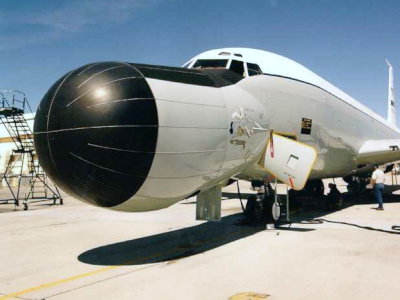


Aircraft 60-0374
The Last ARIA
The support requirements for Apollo, compiled by NASA's Office of Manned Space Flight (OMSF), originally stated a need for twelve heavily instrumented, long-range, high-speed aircraft to supplement the telemetry and communication support to be provided by the Apollo ships. After program refinement that the aircraft requirement would be eight, six to be on station with two standby spares. 60-0374 was one of the original eight Apollo Range Instrumentation Aircraft stationed out of Patrick Air Force Base, Florida.
At the end of the Apollo program, 60-0374 transferred to Wright-Patterson Air Force Base, Ohio. With a new base came a new designation, Advanced Range Instrumentation Aircraft. After a long career as an ARIA aircraft, 60-0374 flew to the National Museum of the Air Force, Dayton, Ohio, for its final flight.
The aircraft arrived earmarked for the Cold War expansion hangar of the National Museum of the Air Force that opened in 2003. The museum made the decision not to include ARIA 60-0374 in the new wing in the eleventh hour allowing the last remaining ARIA aircraft to deteriorate. Unfortunately, the plane is showing the results of this decision by the museum.
Mr. Wes Henry, Chief, Research Division, USAF Museum, responded to an email sent by Bob Guere concerned why ARIA 374 was not in the new Cold War Hangar.
Excerpt from that email:
Also, please keep in mind that we in the museum plan for the long term - that is, we try to think 20 or 30 years ahead. Even though ARIA is currently outdoors, it may not always be, and we have every intention of maintaining it as we do all other display aircraft at the USAF Museum.
I hope this helps explain our thought process regarding the museum's aircraft placement plan. Thank you for your patience and understanding as we work toward the best solution for all of our artifacts.
ARIA 60-0374 continues to be outside ravaged by the elements, a shadow of its former self. Almost 20 years have passed since 374's arrival at the National Museum of the Air Force, with three new hangars built in that time. This specific aircraft supported Project Apollo as an Apollo Range Instrumentation Aircraft and then supported countless programs worldwide as an Advanced Range Instrumentation Aircraft until retirement in 2000. For many of us, this aircraft is more than an airplane. It is a physical reminder of our loss of ARIA 61-0328, and there is comfort in that. I would have hoped that since the ARIA 61-0328 Memorial is in their Memorial Garden that there would have been a consideration to placing this unique aircraft in the Cold War Hanger promptly. With those that served during my time with ARIA, time is our enemy. I sincerely hope I live long enough to see ARIA 374 under a roof as an open display.
Capabilities as of 1996
EC-135E - Basic Telemetry/Cruise Missile Mission Command Aircraft-0. Acquires and tracks TM data using a steerable 7-foot antenna, provides worldwide HF voice communication, and real-time UHF satellite data retransmission. Record, monitors and plays back mission data (2 - 14 track wide-band recorders w/dubbing capability)
1960
Constructed C-135A-BN construction Number 18149.
1966
Conversion to EC-135N with electrical and structural modifications at Douglas Aircraft, Tulsa, Oklahoma.
September 19, 1967
Aircraft arrived at Patrick Air Force Base, Florida.
January 1, 1968
Aircraft Online and Operational as an Apollo Range Instrumentation Aircraft.
December 1975
Transferred to Wright-Patterson Air Force Base, Ohio, 4950th Test Wing operational as an Advanced Range Instrumentation Aircraft.
June 1982
Converted to EC-135E.
1994
Transferred to Edwards Air Force Base, California, 452d Test Flight Squadron.
November 3, 2000
Retired to the National Museum of the Air Force, Dayton, Ohio.
Credit: Randy L. Losey